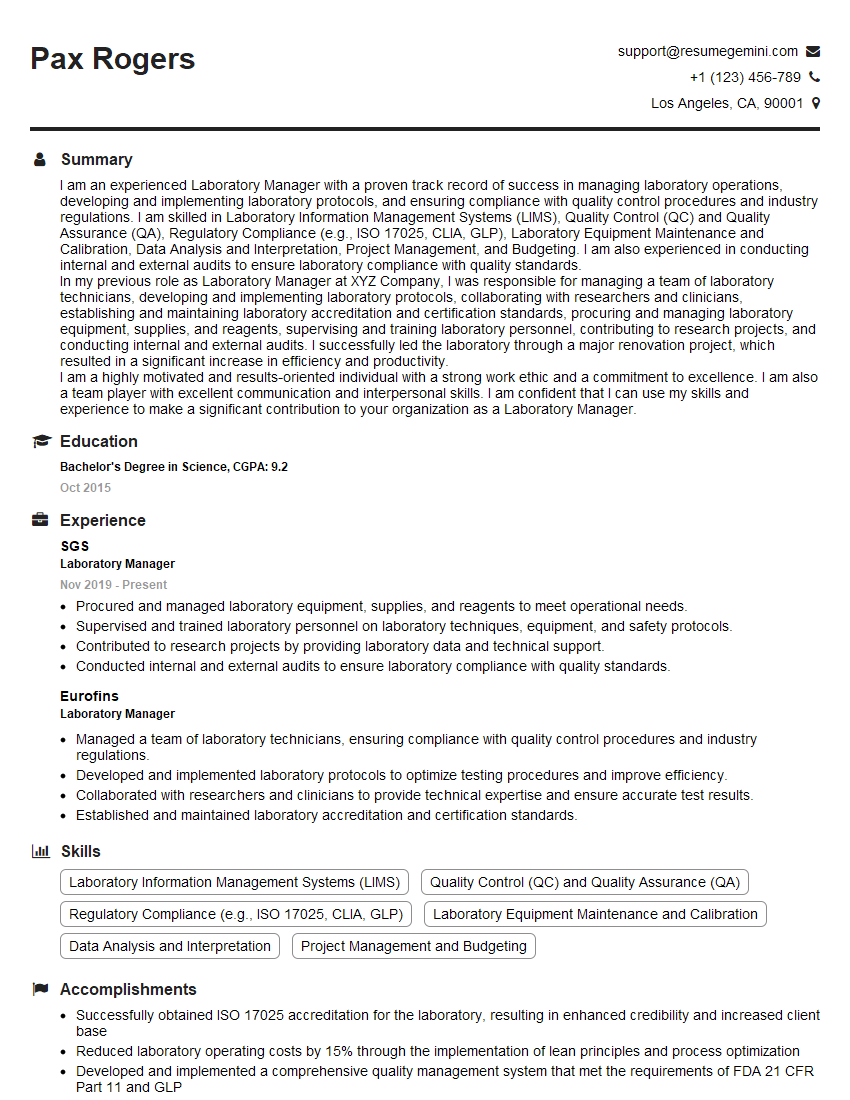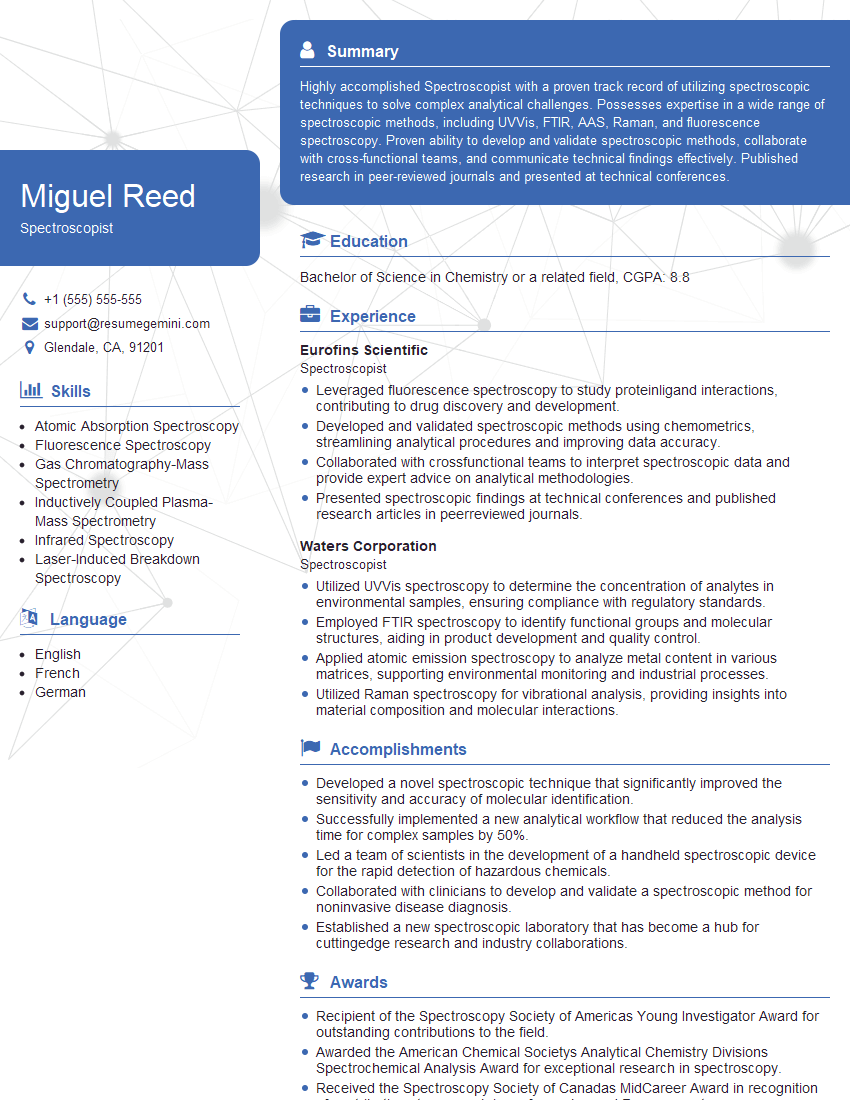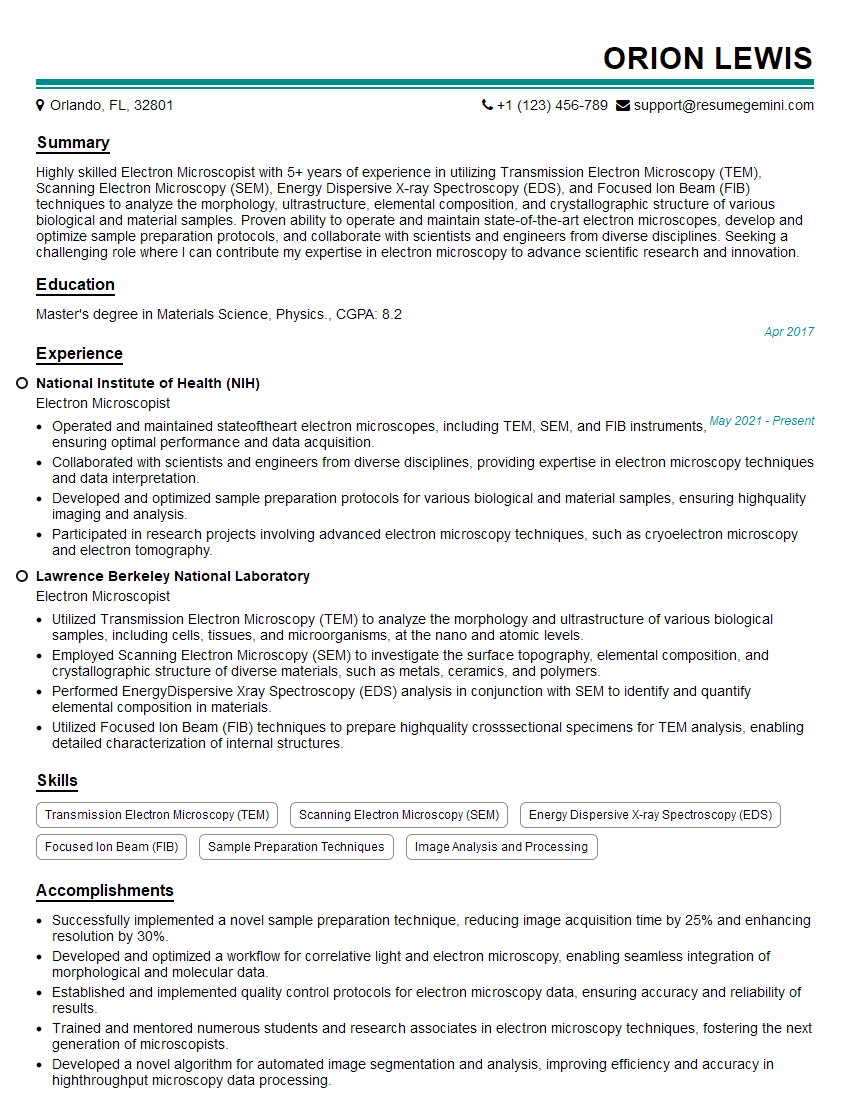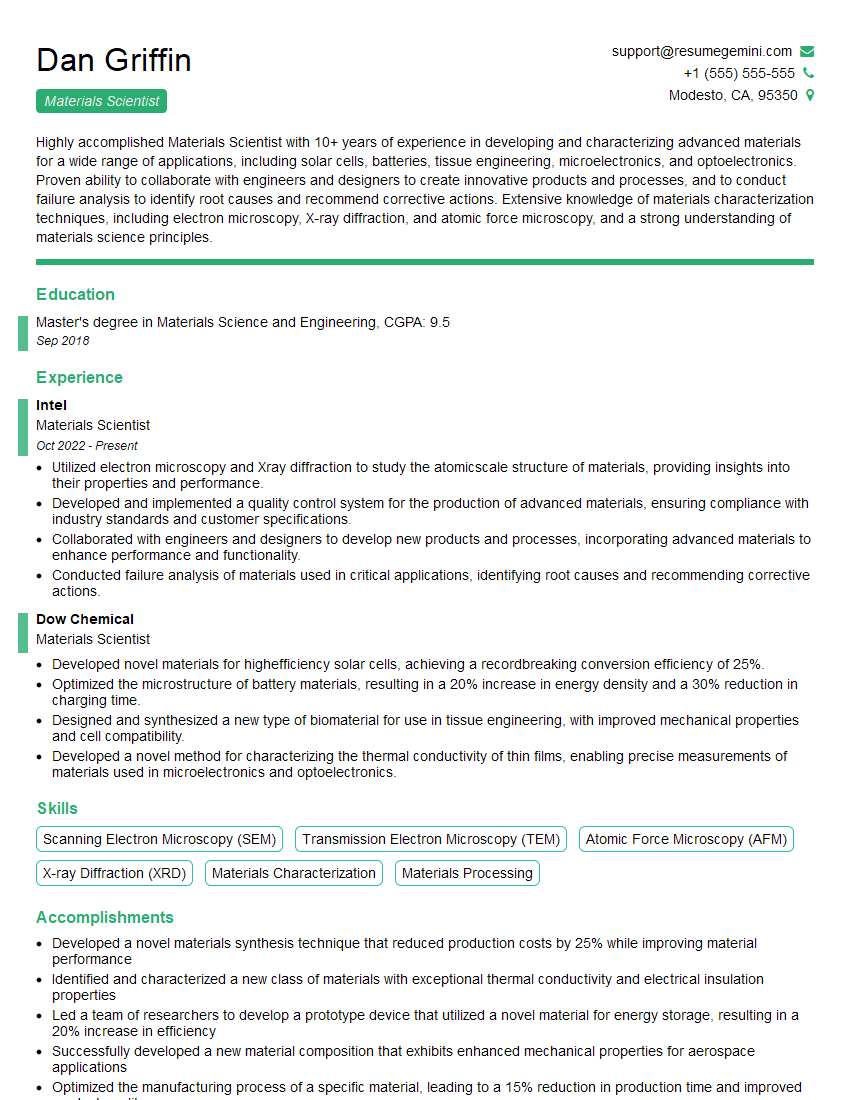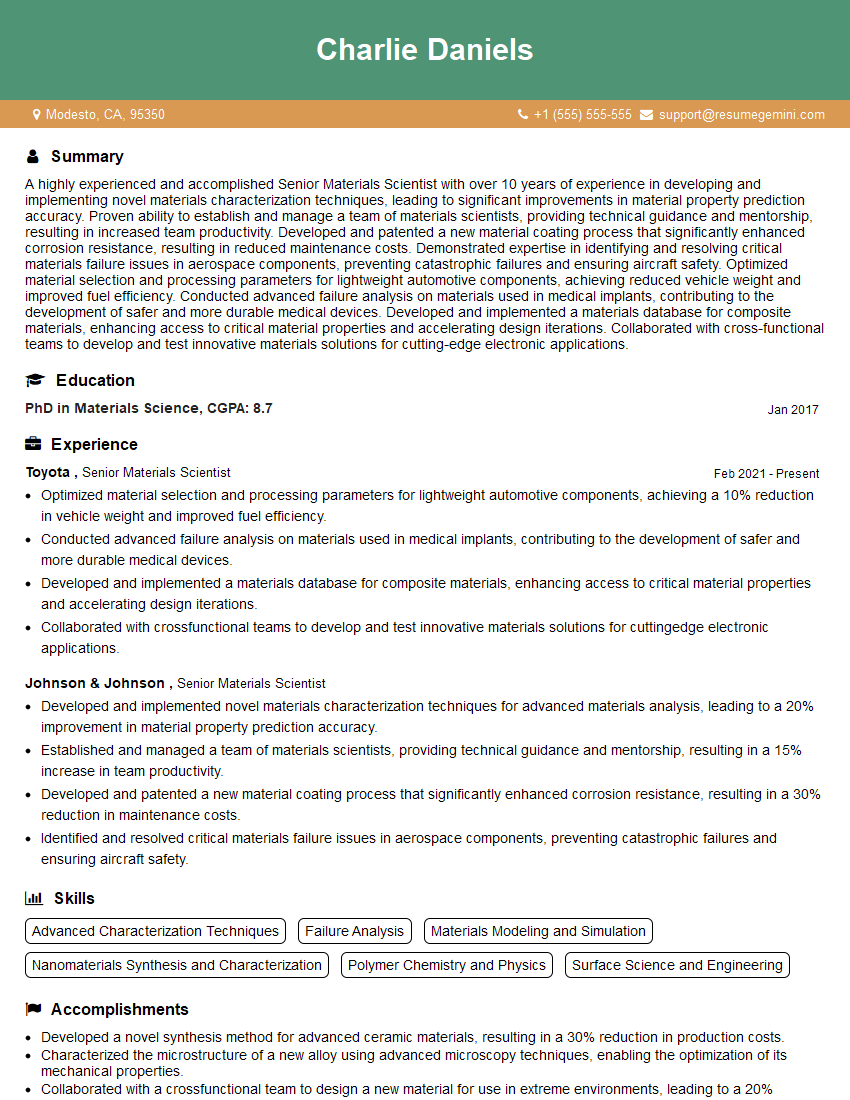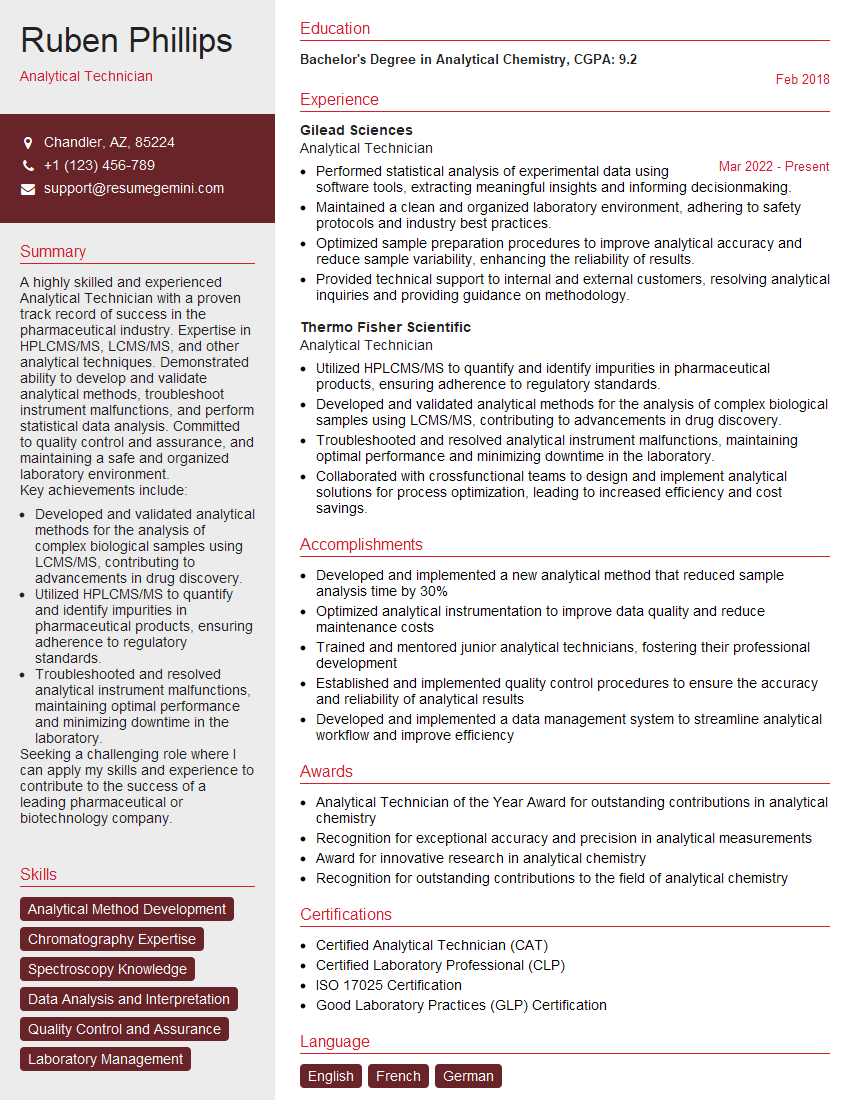The right preparation can turn an interview into an opportunity to showcase your expertise. This guide to Material Composition Analysis interview questions is your ultimate resource, providing key insights and tips to help you ace your responses and stand out as a top candidate.
Questions Asked in Material Composition Analysis Interview
Q 1. Explain the principles of X-ray Diffraction (XRD) and its applications in material composition analysis.
X-ray Diffraction (XRD) is a powerful technique used to identify crystalline materials and determine their crystal structure. It relies on the principle of constructive interference of X-rays scattered by the atoms in a crystal lattice. When a monochromatic X-ray beam hits a crystalline sample, the X-rays are scattered by the atoms in the crystal. If the path difference between the scattered waves is an integer multiple of the X-ray wavelength, constructive interference occurs, producing a diffracted beam. This condition is described by Bragg’s Law: nλ = 2d sinθ, where n is an integer, λ is the X-ray wavelength, d is the interplanar spacing of the crystal lattice, and θ is the angle of incidence.
The resulting diffraction pattern, a plot of intensity versus 2θ, is unique to each crystalline material, acting like a ‘fingerprint’. By comparing the observed diffraction pattern to a database of known materials, we can identify the phases present in the sample. XRD can also provide information about crystallite size, strain, and preferred orientation.
Applications of XRD are widespread, including in materials science, geology, and chemistry. For example, it’s routinely used to identify minerals in rocks, determine the phases in alloys, analyze the crystallinity of polymers, and characterize the structure of thin films.
Q 2. Describe the difference between SEM and TEM microscopy and their respective applications.
Both Scanning Electron Microscopy (SEM) and Transmission Electron Microscopy (TEM) are powerful techniques for imaging materials at the microscopic level, but they differ significantly in their operating principles and applications.
SEM uses a focused beam of electrons to scan the surface of a sample. The interactions of the electrons with the sample generate various signals, including secondary electrons (SE) which provide high-resolution topographic images, and backscattered electrons (BSE) which give information about the sample’s composition. SEM offers relatively simple sample preparation and provides images with good depth of field, making it suitable for visualizing surface features and morphology.
TEM, on the other hand, utilizes a beam of electrons that passes through a very thin sample. The transmitted electrons are used to form an image, providing information about the sample’s internal structure and crystallographic information. TEM offers much higher resolution than SEM, enabling visualization of individual atoms and lattice defects. However, sample preparation for TEM is more challenging and requires ultra-thin sections.
In summary:
- SEM: Surface imaging, morphology, compositional analysis (with EDS), relatively simple sample preparation.
- TEM: Internal structure, high resolution, crystallographic information, more challenging sample preparation.
For example, SEM might be used to inspect the surface quality of a machined part, while TEM might be employed to study the microstructure of a nanomaterial or the arrangement of atoms in a crystal.
Q 3. How does Energy Dispersive X-ray Spectroscopy (EDS) determine the elemental composition of a material?
Energy Dispersive X-ray Spectroscopy (EDS) is a technique used in conjunction with SEM (and other electron microscopy techniques) to determine the elemental composition of a material. It works by detecting the characteristic X-rays emitted by atoms in the sample when they are bombarded with a high-energy electron beam.
When an electron beam interacts with the sample, it can knock out core electrons from the atoms. The resulting vacancy is filled by an electron from a higher energy level, releasing energy in the form of an X-ray photon. The energy of this X-ray photon is characteristic of the element from which it was emitted. EDS detectors measure the energy of these X-rays and count the number of photons at each energy. This data is then used to create a spectrum, showing the relative abundance of each element present in the analyzed area. The peaks in the spectrum correspond to the characteristic X-rays of different elements, allowing for qualitative and quantitative elemental analysis.
Imagine it like a fingerprint for each element; each element leaves a distinct signature in the spectrum based on its unique X-ray energies. By analyzing these signatures, we can identify the elements present and their relative amounts.
Q 4. Explain the principle of Inductively Coupled Plasma Optical Emission Spectrometry (ICP-OES).
Inductively Coupled Plasma Optical Emission Spectrometry (ICP-OES) is a powerful technique for trace elemental analysis in a wide variety of samples. It involves introducing a sample into an inductively coupled plasma (ICP), a high-temperature plasma generated by passing argon gas through a radio-frequency field. This plasma excites the atoms in the sample, causing them to emit light at specific wavelengths.
The emitted light passes through a monochromator, which separates the light into its individual wavelengths. A detector then measures the intensity of light at each wavelength. The intensity of the emitted light is proportional to the concentration of the element in the sample. Each element emits light at a characteristic set of wavelengths, allowing for both qualitative and quantitative analysis. The technique is highly sensitive and can detect very low concentrations of elements.
Imagine a firework display: each element ‘explodes’ with a unique color (wavelength), and ICP-OES measures the brightness (intensity) of each color to determine the amount of each element present. ICP-OES is used extensively in environmental monitoring, food safety, and geological analysis.
Q 5. What are the limitations of using atomic absorption spectroscopy (AAS)?
Atomic Absorption Spectroscopy (AAS) is a sensitive technique for determining the concentration of elements in a sample, but it has certain limitations:
- Limited to one element at a time: Unlike ICP-OES, AAS typically analyzes only one element at a time, requiring sequential analysis for multi-element samples. This can be time-consuming.
- Matrix effects: The presence of other elements in the sample can interfere with the absorption of the target element, requiring careful sample preparation and/or matrix modification.
- Sensitivity limitations: While sensitive for many elements, AAS may not be as sensitive as other techniques like ICP-OES for some elements, especially at very low concentrations.
- Chemical interference: Certain chemical species can interfere with the atomization process, leading to inaccurate results.
For example, if you need a quick analysis of a sample for many elements, AAS might not be the best choice. It is best suited for specific element analysis where high accuracy for a single element is needed and its simplicity outweighs its limitations.
Q 6. Describe the process of sample preparation for X-ray Photoelectron Spectroscopy (XPS).
Sample preparation for X-ray Photoelectron Spectroscopy (XPS) is crucial for obtaining high-quality and reliable data. The goal is to create a clean, representative surface that is free of contamination and representative of the bulk material. Because XPS is highly surface sensitive (analyzing only the top few nanometers), surface cleanliness is paramount.
The process typically involves several steps:
- Careful handling: Preventing contamination from handling, using clean gloves, and specialized tools.
- Cleaning: This may involve various methods depending on the sample material, including ultrasonic cleaning, solvent rinsing, ion sputtering (to remove surface contamination), or other specialized techniques. The choice of cleaning method should not damage the sample or alter the surface chemistry.
- Mounting: The sample is carefully mounted onto a sample holder, ensuring good electrical contact for charge neutralization. This is crucial because XPS can charge insulating samples.
- Transfer to the analysis chamber: The sample is transferred into the ultra-high vacuum (UHV) chamber of the XPS instrument to minimize surface contamination before analysis.
Improper sample preparation can lead to inaccurate results, especially if there is surface contamination masking the desired signal. Therefore, careful attention to detail is required throughout the entire process.
Q 7. How do you interpret a Raman spectrum? What information does it provide about material composition?
A Raman spectrum is a plot of the intensity of scattered light versus the Raman shift (in wavenumbers, cm-1). It provides information about the vibrational modes of molecules and materials. The Raman effect arises from the inelastic scattering of light by molecules; the scattered light has a slightly different energy than the incident light, with the energy difference corresponding to the vibrational energy levels of the molecules. Each peak in the Raman spectrum represents a specific vibrational mode, providing a unique ‘fingerprint’ for the material.
Interpreting a Raman spectrum involves identifying the peaks and assigning them to specific vibrational modes. This requires comparing the observed spectrum to databases of known Raman spectra and understanding the relationship between vibrational modes and molecular structure. The position, intensity, and shape of the peaks provide valuable information about the material’s composition, crystal structure, and even its stress state. The presence or absence of certain peaks can indicate the presence or absence of specific functional groups or phases.
For example, in the analysis of carbon materials, the position of the G and D bands in the Raman spectrum are used to differentiate between graphite and amorphous carbon. A similar approach can be used to analyze a wide array of materials, ranging from polymers to semiconductors and minerals.
Q 8. What are the advantages and disadvantages of using different mass spectrometry techniques for material analysis?
Mass spectrometry techniques offer diverse approaches to material analysis, each with its strengths and weaknesses. Choosing the right technique depends heavily on the material’s properties and the information sought.
- Inductively Coupled Plasma Mass Spectrometry (ICP-MS): Advantages: High sensitivity for trace elements, excellent for elemental analysis in various matrices (liquids, solids after digestion). Disadvantages: Requires sample digestion (can be time-consuming and introduce contamination), may not be suitable for all elements (e.g., refractory elements).
- Secondary Ion Mass Spectrometry (SIMS): Advantages: High spatial resolution, allowing for analysis of very small areas or interfaces, excellent for depth profiling. Disadvantages: Can be destructive, matrix effects can complicate quantitative analysis, relatively expensive.
- Gas Chromatography-Mass Spectrometry (GC-MS): Advantages: Excellent for separating and identifying volatile organic compounds, widely used in environmental and forensic analysis. Disadvantages: Not suitable for non-volatile compounds, requires derivatization for some analytes.
- Matrix-Assisted Laser Desorption/Ionization-Time of Flight Mass Spectrometry (MALDI-TOF MS): Advantages: Soft ionization technique, well-suited for analyzing large biomolecules and polymers. Disadvantages: Matrix can interfere with analysis, requires specialized sample preparation.
For example, if you need to analyze trace metals in a water sample, ICP-MS is a great choice. However, if you need to map the elemental distribution across a semiconductor wafer with high precision, SIMS would be preferred. The decision is not just about sensitivity, but also cost, sample preparation time, and the specific information required.
Q 9. Explain how Fourier Transform Infrared Spectroscopy (FTIR) works and its applications.
Fourier Transform Infrared Spectroscopy (FTIR) is a powerful technique used to identify molecules based on their vibrational modes. Imagine molecules as tiny springs vibrating at specific frequencies; FTIR measures these vibrations.
Infrared light is shone onto a sample. Different functional groups (like C=O, O-H, C-H) in the molecule absorb specific frequencies of this light. The FTIR instrument measures the amount of light absorbed at each frequency, producing a spectrum. This spectrum acts like a fingerprint, uniquely identifying the molecule or its functional groups.
How it works: Instead of scanning frequencies one by one (dispersive spectroscopy), FTIR uses interferometry to simultaneously measure all frequencies. This makes it much faster and more sensitive.
Applications: FTIR is incredibly versatile and used across various fields including:
- Polymer characterization: Identifying polymer types, measuring crystallinity, and assessing degradation.
- Pharmaceutical analysis: Identifying active pharmaceutical ingredients (APIs), verifying purity, and detecting impurities.
- Environmental monitoring: Analyzing pollutants in air, water, and soil.
- Food safety: Detecting contaminants and verifying food authenticity.
For instance, a chemist might use FTIR to identify the components of an unknown plastic sample or a forensic scientist to analyze fibers from a crime scene.
Q 10. How can you identify different phases in a material using XRD?
X-ray diffraction (XRD) is based on the principle of constructive and destructive interference of X-rays interacting with the crystal lattice of a material. Different phases in a material have unique crystal structures, leading to distinct diffraction patterns.
Identifying phases using XRD:
- Acquire the XRD pattern: A powdered sample or a flat surface is exposed to a monochromatic X-ray beam. The diffracted X-rays are detected, producing an intensity vs. 2θ (angle) plot.
- Index the peaks: The positions of the diffraction peaks are analyzed to determine the interplanar spacings (d-spacings) within the crystal lattice using Bragg’s Law:
nλ = 2d sinθ, where n is an integer, λ is the wavelength of X-rays, d is the interplanar spacing, and θ is the diffraction angle. - Compare to database: The indexed d-spacings are compared with standard databases (like the International Centre for Diffraction Data (ICDD) PDF database) to identify the crystalline phases present in the sample.
- Quantitative analysis (optional): The relative intensities of the peaks can be used to determine the relative amounts of each phase present, requiring calibration and potentially Rietveld refinement.
Imagine a mixture of quartz and calcite. Each mineral has a unique XRD pattern. By comparing the measured pattern with the patterns of known minerals in a database, we can identify the presence and relative amounts of quartz and calcite in the mixture.
Q 11. Describe the process of identifying an unknown material using a combination of analytical techniques.
Identifying an unknown material often requires a multi-technique approach for comprehensive characterization. A strategic combination of techniques provides complementary information, leading to a more confident identification.
Step-by-step process:
- Visual inspection and preliminary tests: Observe the material’s physical properties (color, texture, density) and perform simple tests (solubility, magnetic susceptibility).
- Elemental analysis: Use techniques like energy-dispersive X-ray spectroscopy (EDS) or ICP-MS to determine the elemental composition.
- Structural analysis: Employ XRD to identify crystalline phases, and scanning electron microscopy (SEM) or transmission electron microscopy (TEM) to investigate microstructure and morphology.
- Molecular analysis: Use FTIR or Raman spectroscopy to identify functional groups and molecular structure.
- Thermal analysis: Techniques such as thermogravimetric analysis (TGA) and differential scanning calorimetry (DSC) can provide information on thermal stability and phase transitions.
- Data integration and interpretation: Combine the data obtained from various techniques to create a holistic picture of the material’s composition and structure. Databases and spectral libraries can aid in this process.
For example, finding a metallic powder of unknown origin might involve EDS for elemental analysis, XRD for phase identification, and SEM for microstructure examination. The combined information from these techniques would then be used to identify the specific metal and its crystalline structure.
Q 12. What are the common challenges encountered during material composition analysis?
Material composition analysis faces various challenges, from sample preparation to data interpretation.
- Sample heterogeneity: Ensuring representative sampling is crucial, as variations in composition within the material can lead to inaccurate results. Imagine analyzing a rock sample; different parts might have different mineral compositions.
- Sample preparation: Proper sample preparation is essential but can be challenging, particularly for sensitive or complex materials. Incorrect preparation can alter the material’s properties and lead to artifacts in the results.
- Matrix effects: The presence of other components in the sample can interfere with the analysis of the target component, particularly in techniques like ICP-MS or SIMS.
- Instrument limitations: Every instrument has its limitations in terms of detection limits, sensitivity, and spatial resolution. Choosing the appropriate technique is key.
- Data interpretation: Interpreting complex datasets from multiple analytical techniques can be challenging and requires experience and expertise.
- Contamination: Preventing contamination during sample handling and analysis is critical to ensure the accuracy of results.
Addressing these challenges often involves meticulous sample preparation, careful selection of analytical techniques, rigorous quality control measures, and a thorough understanding of the limitations of each technique.
Q 13. How do you ensure the accuracy and reliability of your results in material composition analysis?
Ensuring accurate and reliable results involves a multifaceted approach.
- Proper calibration and standardization: Regular calibration of instruments with certified reference materials is vital to ensure accuracy. This involves measuring known samples and adjusting the instrument’s response to match the known values.
- Quality control samples: Analyzing quality control (QC) samples alongside unknowns helps monitor instrument performance and detect any systematic errors.
- Replicate measurements: Performing replicate measurements on the same sample improves precision and allows for statistical analysis of the data.
- Blank measurements: Analyzing blank samples (without the analyte) helps detect and correct for background signals and potential contamination.
- Method validation: Validation of analytical methods includes assessing parameters like accuracy, precision, detection limits, and linearity to ensure the method is fit for its intended purpose.
- Data analysis and interpretation: Proper statistical analysis of the data is necessary to identify outliers, assess uncertainty, and draw meaningful conclusions.
For example, in a laboratory setting, regularly calibrating an ICP-MS instrument with certified reference materials is essential. Running QC samples alongside unknown samples helps monitor the instrument’s performance over time and allows for early detection of any problems.
Q 14. Explain the concept of calibration in material composition analysis.
Calibration in material composition analysis is the process of relating instrument response to the known concentration of an analyte. It ensures that the instrument’s readings are accurate and reliable.
Methods:
- External calibration: A series of standards with known concentrations are analyzed, and a calibration curve is constructed by plotting instrument response (e.g., peak area or intensity) versus concentration. Unknown samples are then analyzed, and their concentrations are determined by interpolating from the calibration curve.
- Internal standard calibration: An internal standard (a compound with known concentration added to all samples) is used to correct for matrix effects and variations in instrument response. This method helps improve accuracy, particularly in complex samples.
- Standard addition method: Known amounts of the analyte are added to the sample, and the increase in instrument response is measured. Extrapolating back to zero added analyte gives the concentration in the original sample. This is useful when matrix effects are significant.
Imagine analyzing the concentration of a specific metal in a soil sample. External calibration involves creating a series of standard solutions with known metal concentrations, running them through the instrument, and creating a calibration curve. This curve allows the determination of metal concentrations in the soil samples based on their instrument readings.
Q 15. How do you handle outliers or inconsistent data in material analysis?
Handling outliers and inconsistent data is crucial for reliable material analysis. It’s like finding a rogue data point in a perfectly aligned row of soldiers – it immediately stands out and needs attention. My approach involves a multi-step process. First, I visually inspect the data using scatter plots or histograms to identify potential outliers. Then, I delve into the root cause. Is it a genuine anomaly (e.g., a sample contamination), a measurement error (e.g., a faulty sensor), or a data entry mistake? Once identified, I decide on the appropriate course of action. If the outlier is due to a known error, I remove or correct it. If the cause is uncertain, I might use robust statistical methods, such as median instead of mean, or non-parametric tests which are less sensitive to outliers. Alternatively, I might employ techniques like winsorizing or trimming, where extreme values are replaced with less extreme values within a certain range. Ultimately, the decision hinges on a thorough understanding of the data and its source, demanding careful consideration and detailed documentation.
For example, in a recent project analyzing the elemental composition of a polymer blend using Inductively Coupled Plasma Optical Emission Spectrometry (ICP-OES), I detected a single outlier in the concentration of a specific element. After reviewing the laboratory notebook and re-examining the sample preparation, I found a small labeling error, corrected it, and re-ran the analysis, resolving the inconsistency.
Career Expert Tips:
- Ace those interviews! Prepare effectively by reviewing the Top 50 Most Common Interview Questions on ResumeGemini.
- Navigate your job search with confidence! Explore a wide range of Career Tips on ResumeGemini. Learn about common challenges and recommendations to overcome them.
- Craft the perfect resume! Master the Art of Resume Writing with ResumeGemini’s guide. Showcase your unique qualifications and achievements effectively.
- Don’t miss out on holiday savings! Build your dream resume with ResumeGemini’s ATS optimized templates.
Q 16. What is the difference between qualitative and quantitative analysis in material characterization?
Qualitative and quantitative analysis are two complementary approaches to material characterization. Think of it like describing a painting: qualitative analysis focuses on the ‘what’ – the colors, textures, and overall style – while quantitative analysis deals with the ‘how much’ – the precise proportions of each color, the exact dimensions of the canvas, etc.
Qualitative analysis provides descriptive information about the material’s composition. Techniques like X-ray diffraction (XRD) can identify the crystalline phases present in a material, telling us what compounds are there, but not necessarily how much of each. Similarly, scanning electron microscopy (SEM) reveals the material’s microstructure, providing information on its morphology and texture.
Quantitative analysis aims to determine the precise amounts of different components in a material. Techniques like Inductively Coupled Plasma Mass Spectrometry (ICP-MS) measure the concentration of various elements, giving precise numbers. Similarly, Energy-Dispersive X-ray Spectroscopy (EDS) coupled with SEM provides quantitative elemental mapping of the sample.
Often, a combination of both is needed for a comprehensive understanding. For instance, XRD might identify the phases present in an alloy, while quantitative analysis via X-ray fluorescence (XRF) would determine the weight percentage of each phase.
Q 17. Describe your experience with data analysis software used in material composition analysis (e.g., Origin, Matlab).
My experience with data analysis software is extensive. I’m proficient in Origin and Matlab, employing them for diverse tasks throughout the material analysis workflow. Origin is my go-to for data visualization and basic statistical analysis. I frequently use it to create calibration curves, process spectral data, and generate publication-ready graphs. For more complex data manipulation, statistical modeling, and algorithm development, I turn to Matlab. For instance, I’ve written custom scripts in Matlab to automate the processing of large datasets obtained from SEM or XPS, enabling efficient data handling and analysis that would be incredibly time-consuming manually. This automation greatly improves workflow and reduces human error. A typical example involves writing a script to perform peak fitting and background subtraction on XPS data to determine the elemental composition and chemical states.
% Example Matlab code snippet for peak fitting:[fitresult, gof] = fit(x,y,'gauss1');
This code snippet demonstrates a basic Gaussian peak fitting, illustrating my experience with writing customized scripts to perform in-depth analysis.
Q 18. How would you troubleshoot a faulty instrument in the laboratory?
Troubleshooting a faulty instrument follows a systematic approach. It’s like detective work, systematically eliminating potential causes until you pinpoint the problem. First, I start with the simplest checks: Is the instrument properly powered on? Are there any obvious physical obstructions or damage? Then, I check the calibration and instrument parameters. Are the settings correct? Is the calibration curve valid and current? If it’s a spectroscopic instrument, I’ll verify the lamp alignment and detector response. I consult the instrument’s manual for diagnostic procedures and error codes. Many instruments have built-in diagnostics that can provide valuable clues. Next, I check for any recent changes in the instrument’s setup or operation that may have contributed to the fault. I also investigate the sample itself; was it prepared correctly? Could it be interfering with the instrument’s functioning? If the issue persists, I might contact the instrument manufacturer’s support for advanced troubleshooting or repair. Thorough documentation throughout this process is crucial for efficient resolution and preventing future problems.
For example, during an SEM experiment, I encountered an issue with blurry images. After checking the vacuum and focusing, I discovered a misaligned electron beam. Following the manufacturer’s manual, I performed the realignment procedure, restoring normal operation.
Q 19. What safety precautions are necessary when working with specific analytical techniques (e.g., XPS, SEM)?
Safety is paramount in material analysis. Specific analytical techniques demand particular precautions. For example, working with XPS (X-ray Photoelectron Spectroscopy) involves exposure to X-rays, which necessitates shielding and safety interlocks to protect against radiation. Strict adherence to time limits is also vital. Protective eyewear is essential to prevent eye damage from scattered X-rays. The sample preparation should also be considered carefully, as the sample may involve potentially harmful chemicals.
With SEM (Scanning Electron Microscopy), the primary concern is the high vacuum environment and potential exposure to the electron beam. Appropriate safety protocols must be followed when operating the SEM, ensuring proper grounding and avoiding any potential electrical hazards. Moreover, depending on the sample, proper handling techniques for potentially toxic or volatile materials are essential. Samples need appropriate preparation, such as coating with conductive material to prevent charging, and handling needs to be done with the appropriate equipment to prevent accidental contamination. Additionally, some samples might need to be handled in a fume hood due to potential release of volatile substances during processing or during the analysis itself.
In both cases, proper training and adherence to laboratory safety guidelines are essential. Regular safety checks of equipment and procedures are needed to maintain a safe working environment.
Q 20. Describe your experience with specific material types (e.g., polymers, metals, ceramics).
My experience encompasses a wide range of material types. I’ve extensively worked with polymers, analyzing their composition using techniques like pyrolysis-gas chromatography mass spectrometry (Py-GCMS) to identify monomers and additives. I’ve also characterized their morphology and thermal properties using techniques such as Differential Scanning Calorimetry (DSC) and Thermogravimetric Analysis (TGA). This helps in understanding their degradation behavior, a crucial aspect in materials science applications.
With metals, I’ve focused on determining their chemical composition using techniques such as ICP-OES and atomic absorption spectroscopy (AAS). Microstructural analysis, using SEM and XRD, has been key in understanding their mechanical properties and failure mechanisms. I’ve also performed hardness testing and tensile testing to correlate the microstructure with the mechanical behavior.
Regarding ceramics, I’ve characterized their phase composition and crystal structure through XRD and examined their microstructure using SEM. I have explored techniques such as electron probe microanalysis (EPMA) to study their elemental distribution and identify any defects or impurities. I’ve worked with both traditional and advanced ceramics, gaining experience across different applications and material systems. My experience covers the entire lifecycle of materials analysis, from sample preparation to data interpretation and reporting, across these material classes.
Q 21. Explain the concept of grain size and its impact on material properties.
Grain size refers to the average diameter of the individual crystals (grains) in a polycrystalline material. Imagine a mosaic: each tile represents a grain. The size and arrangement of these grains significantly influence the material’s properties.
Smaller grain size generally leads to higher strength and hardness. This is because smaller grains present more grain boundaries, which act as obstacles to dislocation movement. Dislocations are crystal lattice defects that contribute to plastic deformation. More obstacles mean greater resistance to deformation, resulting in improved mechanical strength. Conversely, larger grain sizes often lead to greater ductility (ability to deform before fracturing) but reduced strength.
The impact on other properties is also significant. Grain boundaries can act as pathways for diffusion, affecting properties like corrosion resistance and creep behavior (deformation under sustained stress at high temperatures). Furthermore, grain size can influence electrical and thermal conductivity, as grain boundaries can scatter electrons and phonons (heat carriers). Controlling grain size during material processing is a critical aspect of tailoring the material’s properties for specific applications.
For example, in the production of high-strength steels, fine-grained microstructures are achieved through controlled cooling rates after heat treatments (e.g., quenching and tempering) to enhance material strength.
Q 22. What are the different types of defects that can occur in materials and how do they affect composition?
Material defects are imperfections in the regular arrangement of atoms or molecules within a material. These defects significantly impact a material’s composition and properties. They can be broadly classified into point defects, line defects, and planar defects.
- Point Defects: These are localized imperfections involving a few atoms, such as vacancies (missing atoms), interstitial atoms (extra atoms squeezed into the lattice), and substitutional atoms (one type of atom replacing another).
- Line Defects (Dislocations): These are one-dimensional imperfections, primarily edge dislocations (extra half-plane of atoms) and screw dislocations (spiral ramp of atoms). They affect the material’s strength and ductility.
- Planar Defects: These are two-dimensional imperfections such as grain boundaries (separating regions of different crystal orientations), stacking faults (incorrect stacking of atomic planes), and twin boundaries (mirror image symmetry across a plane).
The presence of defects alters the material’s composition by changing the local atomic arrangement and potentially influencing the concentration of specific elements or phases. For instance, interstitial impurities can change the overall chemical composition, while grain boundaries can segregate certain elements, creating compositional variations across the material.
Example: In steel, the presence of carbon atoms in interstitial sites significantly affects its strength and hardness. More carbon means stronger, harder steel but also more brittle.
Q 23. How does the crystalline structure of a material affect its properties?
The crystalline structure of a material, which describes the arrangement of atoms or molecules in a three-dimensional periodic pattern, profoundly influences its properties. Different crystal structures lead to different atomic bonding configurations and interatomic distances, influencing many material behaviors.
- Mechanical Properties: Crystalline materials with strong, directional bonds (like ceramics) tend to be hard and brittle, while metals with non-directional metallic bonds are typically ductile and malleable. The arrangement of atoms and planes also affects material strength, yield strength, and fracture toughness.
- Electrical Properties: The crystal structure influences the material’s conductivity. For example, the highly ordered structure of silicon in its crystalline form allows for controlled electron flow in semiconductors, while an amorphous silicon structure will not.
- Thermal Properties: The crystal structure and associated bonding affect thermal conductivity and expansion. Materials with more ordered structures often have higher thermal conductivity because heat transfer is more efficient along regular atomic planes.
- Optical Properties: The crystalline structure can affect how the material interacts with light, such as its transparency or color. For example, the arrangement of atoms in a crystal lattice influences the band gap, which determines the material’s ability to absorb or transmit light.
Example: Diamond and graphite are both composed solely of carbon, but their dramatically different properties – hardness vs. softness – stem directly from their different crystal structures (diamond’s strong covalent network vs. graphite’s layered structure).
Q 24. Describe the applications of material composition analysis in various industries (e.g., aerospace, automotive).
Material composition analysis is crucial across many industries. Its applications are diverse, ensuring quality control, optimizing performance, and enabling the development of innovative materials.
- Aerospace: Compositional analysis is vital for ensuring the integrity and reliability of aircraft components. It helps identify impurities, trace elements, and phase distribution in alloys used in engines, airframes, and other critical parts. This guarantees materials meet stringent safety standards.
- Automotive: In the automotive sector, composition analysis is used to monitor the quality of raw materials, such as steel and aluminum alloys, ensuring they meet specified chemical compositions. It also helps in analyzing wear debris to understand wear mechanisms in engines and other components.
- Biomedical: Compositional analysis plays a crucial role in ensuring the biocompatibility of materials used in implants and medical devices. Determining the elemental composition is vital for safety and effectiveness.
- Electronics: Accurate compositional analysis of semiconductors and other materials is essential for producing high-performance microelectronic devices. It allows for process optimization and defect identification.
- Environmental: Material analysis contributes to environmental monitoring by identifying pollutants in soil, water, or air samples. Understanding the composition of waste materials is essential for developing recycling strategies.
The specific techniques used vary depending on the material and the information needed. Common techniques include X-ray fluorescence (XRF), inductively coupled plasma mass spectrometry (ICP-MS), electron microscopy techniques like EDS (Energy Dispersive Spectroscopy), and many others.
Q 25. Explain the concept of chemical bonding and its relevance to material properties.
Chemical bonding describes the forces that hold atoms together in a material. The type of bonding significantly influences a material’s physical and chemical properties. The main types of chemical bonds are:
- Ionic Bonding: This occurs when one atom donates an electron to another, creating positively and negatively charged ions that attract each other. Ionic compounds are typically brittle and have high melting points.
Example: NaCl (sodium chloride) - Covalent Bonding: This involves the sharing of electrons between atoms. Covalent materials can be very strong and have high melting points.
Example: Diamond (C) - Metallic Bonding: This is characterized by a ‘sea’ of delocalized electrons surrounding positively charged metal ions. This type of bonding leads to high electrical and thermal conductivity, as well as ductility and malleability.
Example: Copper (Cu) - Hydrogen Bonding: A special type of dipole-dipole attraction involving hydrogen atoms. It’s relatively weaker than other bonds but crucial in many biological systems.
Example: Water (H2O)
Understanding chemical bonding is crucial because it allows us to predict and explain material properties. For example, the strong covalent bonds in diamond contribute to its exceptional hardness, while the delocalized electrons in metals are responsible for their high electrical conductivity.
Q 26. What are your experience with different standards and regulations related to material analysis?
Throughout my career, I’ve worked extensively with various standards and regulations related to material analysis. These standards ensure consistency, accuracy, and comparability of results across different laboratories and organizations. Some key standards and regulations I’m familiar with include:
- ASTM International (ASTM): Provides numerous standards for material testing and characterization methods, including many focused on compositional analysis. Examples include standards for XRF, ICP-OES, and chemical analysis of specific materials.
- ISO (International Organization for Standardization): Provides international standards for quality management systems (ISO 9001) and specific testing procedures relevant to material characterization. Compliance is essential for maintaining international recognition and credibility.
- Industry-Specific Regulations: Various industries have their own regulations concerning material composition and analysis, such as those governing aerospace components, medical implants, and food packaging materials.
Understanding and adhering to these standards is crucial for ensuring the reliability and validity of analytical results, and ensuring compliance is paramount in all my work.
Q 27. How do you stay up-to-date with the latest advancements in material composition analysis techniques?
Staying current in the rapidly evolving field of material composition analysis requires a multifaceted approach.
- Scientific Publications: I regularly read peer-reviewed journals (like Analytical Chemistry, Materials Science and Engineering) and attend conferences to learn about the latest advancements in instrumentation and analytical techniques.
- Professional Organizations: Membership in professional organizations like the Materials Research Society (MRS) and ASTM International provides access to conferences, workshops, and networking opportunities that help me stay abreast of developments.
- Vendor Information: I actively engage with instrument manufacturers and suppliers to learn about new instrumentation capabilities, software upgrades, and application notes.
- Online Resources: I utilize online databases and resources such as Web of Science and Scopus to search for relevant publications and keep track of emerging trends.
Continuous learning is critical for maintaining expertise in this field. Keeping updated is not only intellectually stimulating, but also essential to deliver the most accurate and effective analytical services.
Q 28. Describe a time when you had to solve a complex problem related to material analysis.
In a previous role, we encountered a significant challenge analyzing the composition of a novel high-temperature alloy. Initial analyses using standard XRF techniques yielded inconsistent and unreliable results. The alloy contained trace elements that were difficult to quantify accurately using standard methods.
To overcome this, I adopted a multi-pronged approach:
- Method Optimization: We meticulously optimized the XRF parameters (e.g., tube voltage, beam filters) to improve sensitivity for the challenging elements.
- Alternative Techniques: We complemented XRF with ICP-MS, which provided higher sensitivity and accuracy for the trace elements.
- Matrix Matching: We prepared calibration standards closely matching the alloy’s matrix to minimize matrix effects and improve analytical accuracy.
- Data Validation: We rigorously validated the analytical results using multiple independent measurements and statistical analysis to ensure reliability.
This systematic approach resulted in accurate and reliable compositional data, allowing us to successfully characterize the alloy and guide further material development. The experience highlighted the importance of a flexible, problem-solving approach and the need to skillfully combine different analytical techniques for complex material characterization.
Key Topics to Learn for Material Composition Analysis Interview
- Spectroscopic Techniques: Understand the principles and applications of various spectroscopic methods like X-ray diffraction (XRD), X-ray fluorescence (XRF), energy-dispersive X-ray spectroscopy (EDS), and infrared spectroscopy (IR) for material characterization. Be prepared to discuss their strengths, limitations, and suitable applications.
- Microscopic Techniques: Familiarize yourself with microscopic analysis techniques such as scanning electron microscopy (SEM), transmission electron microscopy (TEM), and optical microscopy. Focus on sample preparation, image interpretation, and relating microstructural features to material properties.
- Chemical Analysis Methods: Master the fundamental principles of wet chemical analysis, including titration, gravimetric analysis, and other relevant techniques. Understand their role in determining elemental composition and purity.
- Data Analysis and Interpretation: Develop your skills in interpreting complex datasets generated from various analytical techniques. Practice identifying patterns, drawing conclusions, and communicating your findings effectively.
- Quality Control and Assurance: Understand the importance of quality control in material composition analysis, including calibration procedures, standard operating procedures (SOPs), and error analysis.
- Practical Applications: Be ready to discuss the application of material composition analysis in various industries, such as manufacturing, pharmaceuticals, environmental science, and forensics. Consider examples related to quality control, failure analysis, and materials development.
- Problem-Solving and Troubleshooting: Develop your ability to troubleshoot common problems encountered during material analysis, including instrument malfunctions, sample preparation issues, and data interpretation challenges. Be prepared to describe your approach to solving analytical problems.
Next Steps
Mastering Material Composition Analysis is crucial for career advancement in many high-demand fields. A strong understanding of these techniques opens doors to exciting opportunities and positions you as a valuable asset to any team. To maximize your job prospects, it’s essential to craft a resume that effectively showcases your skills and experience to Applicant Tracking Systems (ATS). We highly recommend using ResumeGemini to create a professional and ATS-friendly resume. ResumeGemini provides valuable tools and resources to help you build a compelling resume that highlights your expertise in Material Composition Analysis. Examples of resumes tailored to this field are available to guide you.
Explore more articles
Users Rating of Our Blogs
Share Your Experience
We value your feedback! Please rate our content and share your thoughts (optional).
What Readers Say About Our Blog
Hello,
We found issues with your domain’s email setup that may be sending your messages to spam or blocking them completely. InboxShield Mini shows you how to fix it in minutes — no tech skills required.
Scan your domain now for details: https://inboxshield-mini.com/
— Adam @ InboxShield Mini
Reply STOP to unsubscribe
Hi, are you owner of interviewgemini.com? What if I told you I could help you find extra time in your schedule, reconnect with leads you didn’t even realize you missed, and bring in more “I want to work with you” conversations, without increasing your ad spend or hiring a full-time employee?
All with a flexible, budget-friendly service that could easily pay for itself. Sounds good?
Would it be nice to jump on a quick 10-minute call so I can show you exactly how we make this work?
Best,
Hapei
Marketing Director
Hey, I know you’re the owner of interviewgemini.com. I’ll be quick.
Fundraising for your business is tough and time-consuming. We make it easier by guaranteeing two private investor meetings each month, for six months. No demos, no pitch events – just direct introductions to active investors matched to your startup.
If youR17;re raising, this could help you build real momentum. Want me to send more info?
Hi, I represent an SEO company that specialises in getting you AI citations and higher rankings on Google. I’d like to offer you a 100% free SEO audit for your website. Would you be interested?
Hi, I represent an SEO company that specialises in getting you AI citations and higher rankings on Google. I’d like to offer you a 100% free SEO audit for your website. Would you be interested?
good
